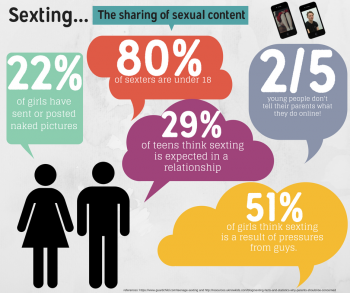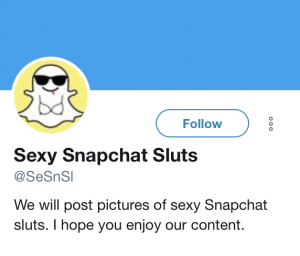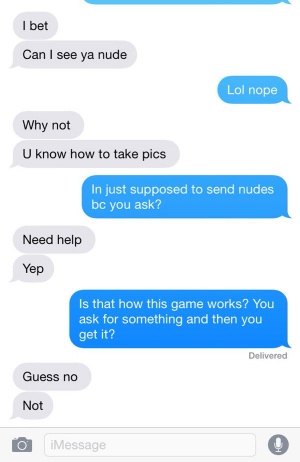Sexting
Sexting has become extremely prevalent in the era of smartphones and social media, and, while it is done by people of all ages [3], it is more notably associated with adolescents and young adults. Sexting's popularity is still relatively recent, therefore both the ethics and legislation surrounding it are still being developed. Sexting is often seen as acceptable in certain relationships, but there are many circumstances where it is still seen as taboo behavior.
Contents
Social Media
Social media is often discussed as a way for users to express themselves and digitize aspects of their character on a medium to share with others. Deborah Lupton discusses how bodies are being digitized like never before through the ways in which sexting intersects our bodies with technology. Many ethical concerns come about in this realm. Lupton says that "in this age of unceasing collection of often very intimate and personal information about people via digital technologies, questions of data security and data privacy have become paramount" [4]. Once personal digital data enters the computing cloud, people lose control over how they are protected and controlled; once you send a sext, it is impossible to know who may wind up finding it. Its ethical implications are not limited to just loss of control over your data. Since it’s development, sexting has prompted privacy concerns, created a whole new form of sexual harassment and bullying, raised new issues regarding consent, and sparked the creation of legislation.
Kik
One of the first social media applications that brought about the idea of sexting as a prominent issue is Kik. Kik was started in 2009 by students at the University of Waterloo in Canada. Kik has over 300 million registered users with a large portion of those users being young adults. Kik allows people to register with a username that preserves their identity, but makes this application more prone to sexting and predators. As people found out that a user's identity could be hidden on Kik, sexting increased significantly. Many users have reported that they have received sexually explicit messages through the application, and many scholars have noted Kik as an unsafe application [5].
Snapchat
Snapchat was first created in 2011 by Stanford alum Bobby Murphy and Stanford dropout Evan Spiegel for a product design class. The application was rated for users twelve as a multimedia messaging application in which you can share moments with friends quickly. Users set how long they want their message to be viewed for and then they can send it. The receiving user may only see the message for that certain amount of time and then it disappears forever [6].
Since its launch, Snapchat has been notoriously known as a sexting application [7]It was even named, “the greatest tool for sexting since the front-facing camera” [8]. People feel a sense of safety and in sending their nude photos because they disappear, or are deleted, from the company’s server. However, what happens when those photos are not permanently deleted or removed but, instead, stay in circulation on the Internet and its platforms?
Ethical Concerns
Privacy and Voyeurism
There are ways that receivers of snapchats can save them forever [9]. They can screenshot the snapchat, which notifies the sender, or they can use someone else’s phone to take a photo of the snapchat which avoids the screenshot notification. In the latter, the sender would be under the false assumption that their photo had disappeared because they never received a screenshot notification. Apps have been created for purchase that will also save snapchats without notifying the sender of it. This is an invasion of both physical privacy and decisional privacy, for the original sender of the photos no longer has the freedom to decide who views the photos of their exposed body [10]. These photos are going on to be shared with wide audiences and appearing on various social media accounts. For instance, the Twitter accounts like ‘Sexy Snapchat Sluts,’ ‘Snapchat sluts’ or ‘Snapchat_Sluts.’ These public Twitter accounts share the nude photos of strangers for anyone to see, allowing anyone to become voyeurs. As Tony Doyle stated in Privacy and Perfect Voyeurism, “Persons are worthy of having their autonomy respected because they are persons,” [11] and accounts like these blatantly take away people’s autonomy. These accounts also violate people's privacy, which one can argue is sacrificed when someone decides to send a nude, but like autonomy, people are entitled to their own degree of privacy. Gavison writes that "privacy is [...] a shield that can protect [one] from embarrassment and enable [he or she] to maintain [their] self respect," but due to applications like Snapchat and the growing prevalence of sexting, this shield has drastically diminished.
Sexual Harassment and Bullying
Sexual harassment is bullying or coercion of a sexual nature, and sexting is often a result of one person in the exchange asking or telling someone to send photos of themselves. It is characterized as sexual harassment, many times, because the request is unwarranted and someone might be coerced into sending photos.
Public humiliation and sexual shame is something often result from the spreading of someone’s photos after they partook in sexting. In September of 2010, a video called Megan’s Story was put on YouTube to teach a message about sexting and demonstrate that, once you share something digitally, you lose control over who sees it and what they do with it [12].
- “The video begins with a teenaged girl called Megan, as she emerges from a women's bathroom into a school hallway. She holds her phone in her hand. She smiles to herself as she fastens the top button on her shirt. As she enters a classroom, we hear a mobile phone beep, as a boy in the class receives her message. Then we hear new beeps around the room, as the image is forwarded to other classmates. Another boy turns to her and nods suggestively. The teacher arrives and begins to mark the roll. Shots of Megan looking increasingly worried and upset are intercut with the beeping sound of incoming messages, and shots of her classmate's stares. Girls look at their phones, glare at Megan, and then turn away in disgust. Megan is close to tears. Finally the teacher's phone beeps. He looks at it, looks at Megan, and shakes his head in disappointment. Megan breaks down and runs from the room.”[13]
The sharing of these photos is a form of cyberbullying that many adolescents experience. Having something that you sent privately for a particular person to see, shared publicly and spread around is an invasion of one’s privacy and sexual freedom. Not only that but “depression, suicide, mood disorder, adjustment reactions, and anxiety disorders are some potential mental health implications that can arise after falling victim to sexting” [14].
Sexual Pressure and Coercion
Another problem pertaining to sexting is that it is prevalent among adolescents and youths with little to no prior sexual experience. While young people are passing through puberty, they are in a stage where sexual exploration and expression may take on increased importance in their lives [15]. With the new technologies in place, adolescents are in a stronger position to be taken advantage of and coerced into sending nude photos of themselves.
Pressure and/or coercion is a key reason why young females (in particular) send images of themselves to others (typically young males). There are a variety of ways that this pressure and coercion can formulate.
Individual Pressure
Individual pressure is best defined as the form of pressure that exists within the relationship of two sexting partners [16]. Individual pressure is also the type of pressure that typically becomes coercive. This type of pressure could entail one partner in a relationship asking for a nude image and the other partner feels obligated to send because they are in a relationship. The severity of this situation is mild but it is still coercion because the sender did not have the desire to send the photos. In a more serious example, individual pressure could involve an individual being blackmailed into sending nude images of themselves because of some threat of maybe violence, shaming, or humiliation. This example of coercion also categorizes as cyberbullying.
Peer Group Pressure
Sexting behaviors may be positively reinforced within group culture. While this type of pressure is not necessarily sexual coercion, it still puts pressure on young individual to sext, even if they do not have the desire to do so. Group dynamics can influence individuals to sext because, if everyone in the group is participating in the sexting culture, then one individual member may feel less included in the group unless they, too, participate in the act of sexting.
Consent
Sexting raises a plethora of new issues surrounding consent. As a result of pressure and coercion at the range of many levels it is legitimate to question whether young women in some instances are able to fully and freely ‘consent’ to the activity even where they produce and send the image ‘consensually’. Additionally, consent is not always given and photos are sent to people who do not want to receive them. As mentioned previously, this is a blatant form of sexual harassment.
One of the commonly used terms in regards to non-consensual sexting is the "dick-pic." It has become a trend for males to send dick pics to others with no previous indication of the receiver asking or wanting to receive a photo. In fact, four in ten women between the ages of 18 and 36 report having being sent a dick pic without consent, while only 5% of men in this demographic reported having received unsolicited nude photos [17]. There have even been reports of women receiving dick pics via Airdrop, making anyone with the feature turned on susceptible. Law makers are calling the senders cyberflashers. In the UK, cyberflashing can yield up to two years in prison.
However, the law views people under the age of 18 as being unable to give consent to sexting, even when many of them are over the legal age for sexual consent in their state. As of August 1, 2018, the age of consent in 38 out of the 50 states is under 18 [18]. This is particularly problematic because sexting is most prevalent among adolescents who already view themselves as having full sexual agency. Because of the laws set in place, a teenage who sexts consensually could be committing four different crimes: “solicitation, production, distribution and possession of child pornography” [19]. This has caused states to begin regulating the act of sexting amongst teenagers.
Legislation
Many states have taken action to create laws that they feel will properly solve this ethical dilemma. Vermont, for instance, created an exception for consensual sexting between teenagers of specific ages. Vermont Senate Bill 125 amended child pornography laws to exclude persons “less than 19 years old, [when] the child is at least 13 years old, and the child knowingly and voluntarily and without threat of coercion used an electronic communication device to transmit an image of himself or herself to the person” [20]. Other states, however, have created stricter sex offender laws in response to sexting. In 2012, South Dakota criminalized a minor’s intentional creation, transmission, possession, or distribution of “any visual depiction of a minor in any condition of nudity or involved in any prohibited sexual act” [21]. Another varying legal approach is educational programs. New York Assembly Bill 8131 “directs the attorney general to establish a 2-year juvenile sexting and cyberbullying education demonstration program in not less than 3 counties as a diversionary program for persons under 16 who have engaged in cyberbullying or sexting, in lieu of juvenile delinquency or criminal proceedings” [22]. A large ethical dilemma surrounding sexting is that many states fail to have existing laws regarding it. In these such states, prosecutors are left to follow the laws that are already established, mainly child pornography or obscenity laws. This often results in teens being labeled as sex offenders which is something that could permanently alter their lives in a negative way.
References
- ↑ Poltash, Nicole A. "Snapchat and Sexting: A Snapshot of Baring Your Bare Essentials," Richmond Journal of Law & Technology vol. 19, no. 4 (2013): p. 1-24. HeinOnline, https://heinonline.org/HOL/P?h=hein.journals/jolt19&i=654.
- ↑ Lenhart, A. 2009. Teens and sexting, Pew Internet Research, December 15, http://www.pewinternet.org/Reports/2009/Teens-and-Sexting.aspx (accessed April 30, 2010) [Google Scholar]
- ↑ McDaniel, Brandon T.; Drouin, Michelle (November 2015). "Sexting among married couples: who is doing it, and are they more satisfied?". Cyberpsychology, Behavior, and Social Networking. 18 (11): 628–634. doi:10.1089/cyber.2015.0334. PMC 4642829. PMID 26484980.
- ↑ Lupton, Deborah, Digital Bodies (May 15, 2015). Available at SSRN: https://ssrn.com/abstract=2606467 or http://dx.doi.org/10.2139/ssrn.2606467
- ↑ Moloney, Aisling. "What is Kik Messenger and Is It Safe?," Metro News (2017), https://metro.co.uk/2017/08/22/what-is-kik-messenger-and-is-it-safe-6870370/
- ↑ Poltash, Nicole A. "Snapchat and Sexting: A Snapshot of Baring Your Bare Essentials," Richmond Journal of Law & Technology vol. 19, no. 4 (2013): p. 1-24. HeinOnline, https://libproxy.law.umich.edu:2195/HOL/P?h=hein.journals/jolt19&i=645
- ↑ Hill, Kashmir ’This Sext Message Will Self Destruct in Five Seconds’, FORBES, https://www.forbes.com/sites/kashmirhill/2012/05/07/fantastic-theres-a-quick-erase-app-for-sending-your-nude-photos/#7296e8e937f2
- ↑ Poltash, Nicole A. "Snapchat and Sexting: A Snapshot of Baring Your Bare Essentials," Richmond Journal of Law & Technology vol. 19, no. 4 (2013): p. 1-24. HeinOnline, https://heinonline.org/HOL/P?h=hein.journals/jolt19&i=654.
- ↑ Notopoulos, Katie. “How Anybody Can Secretly Save Your Snapchat Videos Forever.” BuzzFeed News, BuzzFeed News, 28 Dec. 2012, www.buzzfeednews.com/article/katienotopoulos/how-anybody-can-secretly-save-your-snapchat-videos.
- ↑ Floridi, Luciano. The 4th Revolution: How the Infosphere Is Reshaping Human Reality. Oxford University Press, 2016
- ↑ Doyle, Tony. “Privacy and Perfect Voyeurism.” Ethics and Information Technology, vol. 11, no. 3, 2009, pp. 181–189., doi:10.1007/s10676-009-9195-9
- ↑ ThinkUKnowAustralia. 2010a. Megan's Story. http://www.youtube.com/user/ThinkUKnowAUS#p/u/0/DwKgg35YbC4
- ↑ Kath Albury & Kate Crawford (2012) Sexting, consent and young people's ethics: Beyond Megan's Story, Continuum, 26:3, 463-473, DOI: 10.1080/10304312.2012.665840
- ↑ Sexting and Cyberbullying in the Developmental Context. Judge, Abigail Sossong, Anthony D. Child, and Adolescent Psychiatry and the Media 2018
- ↑ Murray Lee, Thomas Crofts, Gender, Pressure, Coercion and Pleasure: Untangling Motivations for Sexting Between Young People, The British Journal of Criminology, Volume 55, Issue 3, May 2015, Pages 454–473, https://doi.org/10.1093/bjc/azu075
- ↑ Murray Lee, Thomas Crofts, Gender, Pressure, Coercion and Pleasure: Untangling Motivations for Sexting Between Young People, The British Journal of Criminology, Volume 55, Issue 3, May 2015, Pages 454–473, https://doi.org/10.1093/bjc/azu075
- ↑ “What makes men send dick pics?.” Moya Sarner, The Guardian, 18 Mar. 2019, en.m.wikipedia.org/wiki/Ages_of_consent_in_the_United_States
- ↑ “Ages of Consent in the United States.” Wikipedia, Wikimedia Foundation, 14 Mar. 2019, en.m.wikipedia.org/wiki/Ages_of_consent_in_the_United_States
- ↑ Poltash, Nicole A. "Snapchat and Sexting: A Snapshot of Baring Your Bare Essentials," Richmond Journal of Law & Technology vol. 19, no. 4 (2013): p. 1-24. HeinOnline, https://libproxy.law.umich.edu:2195/HOL/P?h=hein.journals/jolt19&i=645
- ↑ S. 125, 2009 Leg., Reg. Less. (Vt. 2009), available at http://www.leg.state.vt.us/docs/2010/Acts/ACT058.pdf
- ↑ S. 183, 2012 Leg., 87th Sess. (S.D. 2012), available at http://legis.state.sd.us/sessions/2012/Bill.aspx?File=SB183P.htm
- ↑ Assembly. B. No. A08131, 2011 Leg., Reg. Less. (N.Y. 2012) available at http://assembly.state.ny.us/leg/?default_fld=&bn=A08131&term=2011&Summary=Y&Text=Y


